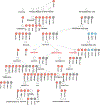An Integrated Understanding of the Rapid Metabolic Benefits of a Carbohydrate-Restricted Diet on Hepatic Steatosis in Humans
- PMID: 29456073
- PMCID: PMC6706084
- DOI: 10.1016/j.cmet.2018.01.005
An Integrated Understanding of the Rapid Metabolic Benefits of a Carbohydrate-Restricted Diet on Hepatic Steatosis in Humans
Abstract
A carbohydrate-restricted diet is a widely recommended intervention for non-alcoholic fatty liver disease (NAFLD), but a systematic perspective on the multiple benefits of this diet is lacking. Here, we performed a short-term intervention with an isocaloric low-carbohydrate diet with increased protein content in obese subjects with NAFLD and characterized the resulting alterations in metabolism and the gut microbiota using a multi-omics approach. We observed rapid and dramatic reductions of liver fat and other cardiometabolic risk factors paralleled by (1) marked decreases in hepatic de novo lipogenesis; (2) large increases in serum β-hydroxybutyrate concentrations, reflecting increased mitochondrial β-oxidation; and (3) rapid increases in folate-producing Streptococcus and serum folate concentrations. Liver transcriptomic analysis on biopsy samples from a second cohort revealed downregulation of the fatty acid synthesis pathway and upregulation of folate-mediated one-carbon metabolism and fatty acid oxidation pathways. Our results highlight the potential of exploring diet-microbiota interactions for treating NAFLD.
Trial registration: ClinicalTrials.gov NCT02558530.
Keywords: FGF21; NAFLD; PPAR-α; Streptococcus; carbohydrate-restricted diet; folate; inflammation; microbiome; multi-omics; β-oxidation.
Copyright © 2018 Elsevier Inc. All rights reserved.
Figures






References
-
- Akesson B, Fehling C, Jagerstad M, and Stenram U (1982). Effect of experimental folate deficiency on lipid metabolism in liver and brain. Br. J. Nutr. 47, 505–520. - PubMed
-
- Asrih M, and Jornayvaz FR (2013). Inflammation as a potential link between nonalcoholic fatty liver disease and insulin resistance. J. Endocrinol. 218, R25–R36. - PubMed
-
- Astrup A, Meinert Larsen T, and Harper A (2004). Atkins and other low-carbohydrate diets: hoax or an effective tool for weight loss? Lancet 364, 897–899. - PubMed
Publication types
MeSH terms
Substances
Associated data
Grants and funding
LinkOut - more resources
Full Text Sources
Other Literature Sources
Medical
Molecular Biology Databases

